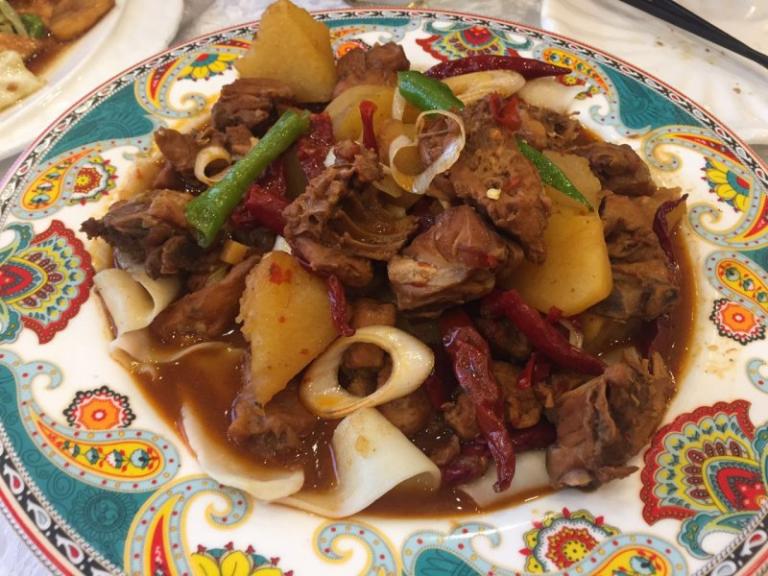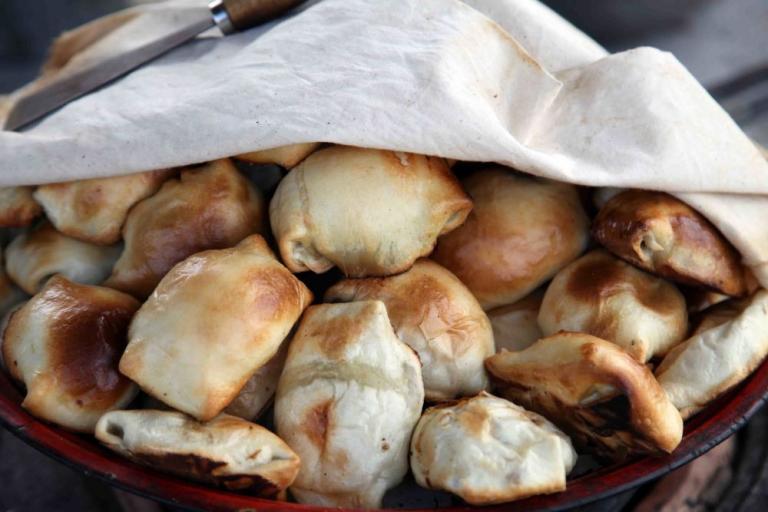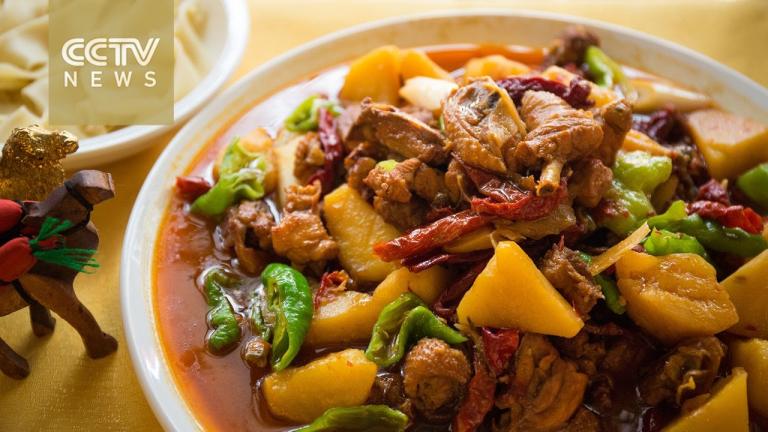Pyramid on the Dining Table
8 min readAccording to a legend, over 1,000 years ago, there was a doctor named Abuaili Yibixina. In his old age, he was in poor health and it turned out in vain even if he had lots ofmedicine. Later, he invented a kind of food for him to do food therapy. He chose mutton, carrot, onion, boiled oil, mutton fat and rice, braising them with slow fire after adding water and salt. This kind of food has attractive color, scent and flavor, so it could whet people’s appetite. He had a bowl of this in the morning and in the evening; half a month passed, he gradually restored his health. People around were very surprised and thought he had taken some magical medicine. Later, he passed this “medicine”on to the people around.so it spread far and wide, finally becoming pilaf nowadays. The poet named Xiao Xiong in the Qing Dynasty(1616 A.D. to 1911 A.D.) wrote in Eating and Drinking,”Naan is deep yellow and rice tasty; soup and cake are made with beef and mutton. No chopsticks can be borrowed, so people use hand to eat around the dining table.”He mentioned pilaf in the poem. The writer, in Notes, said “The food is eaten with hand, named pilaf. When celebrating something, this will be prepared to entertain the guests.”Either the poem of the Qing Dynasty or the ancient legend fully indicates that the history of pilaf in Xinjiang started long time ago.

The people of Uygur and Uzbek eat rice basically in the form of pilaf. It is named poluo, made with major ingredients such as mutton, rice, boiled oil, carrot and onion, through sauting, boiling and braising and other cooking methods. The cooked pilaf is greasy and savory with rich nutrition. Carrot is the core of pilaf, which is called “small ginseng”and”ground ginseng”, tonifying and engendering blood, helping produce saliva and slaking thirst and tranquilizing the mind and promoting intelligence in pharmacology. Onion, called piyaz by people in Xin jiang, is also an indispensable ingredient in pilaf, containing lots of protein, amino acid and saccharides, as well as mercaptan, disulfide and trisulfide and other constituents. In pharmacology, it has the efficacy of dispelling the wind, sweating,relieving exterior syndrome and detumescence, and can cure common cold due to wind cold, headaches, nasal congestion, stroke, edema and dysentery. It is proved by modern medicine that onion functions to dissolve intravascular thrombus. Therefore, onion is called queen of vegetables in the Western countries. The Muslim people in Xin jiangcombine such food ingredients organically, so it becomes a kind of food with strong nourishment because of the rich nutrition it contains. Pilaf is called men’s nourishment by Uygur and”complete nourishment food”by the Han People in Xin jiang.
I heard long ago that in Shufu County, Kashgar Prefecture, there is a boss Mehmet Yiming and his renowned pilaf having lasted for three generations, but I hadn’t hada chance to try it before. In the summer of 2008,I was lucky to be in that county, so certainly I couldn’t lose such a chance to taste such renowned pilaf. The pilaf restaurant of Mehmet Yiming is located in the Jinbaza road, about 90 square meters with two rooms: the inner room and the outer room. It was about noon when we got there by car, and the guests werein endless stream. When we entered the restaurant, the smell of fragrance made us have a good appetite. The glossy pilaf was surely extraordinary for its scent and flavor, soI started to believe the rumor was not an exaggeration. Mehmet Yiming told me that he was the third generation in his family to make pilaf: the first generation was his grandfather, Mehmet Rozi; and the second was his father, Zunun Mehmet. However, the luck of his grandfather and father was far worse than his. In the early years after liberation, the pilafrestaurant of his father didn’t last long because of the policies at that time. In the early years of the Reform and Opening-up, Mehmet used the only 50 Yuan in his pocket to start a pilaf stand. With hardworking and intelligence, he became a millionaire 10 years later. It is more than what is mentioned above: he hangs the sign “Three-Generation Uygur Pilaf”and opens up to now. Speaking of pilaf,I asked whether there was any secret. He smiled and told me,”There is no secret really, but ingredients matters most. Rice and mutton must be fresh, and it had better be whether of 1 or 2 years’ age; it should be vegetable oil other than sheep tail oil. How much mutton to put in and the time and procedure to put in each ingredient all relate to the flavor of pilaf. For example, both the quantity of carrot to put in and the time of frying it influence the flavor. Carrot should be much. Fuel should be dry apricot, mulberry or euphrates poplar firewood.”I asked,”Why should it be firewood?”He said,”Such firewood can burn for a long time with stable fire, so the temperature of the furnace can be controlled, and that it is not easy to burn the food so the food will tastebetter. These are the experiences from our forefathers.”After eating the food, my curiosity drove me to have a look at the kitchen. When I just got there,I saw Mehmet Yiming’s wife, Yibaguli Ezizi cutting mutton with a balance beside her, with which she weighed each piece of mutton she cut.I was curious why she had to do this. She said,”Everybody pays the same, so they should eat the same mutton, and each slice of mutton should be the same.”The three”sames”was a reflection of no cheating, which I thought was also one of thereasons for their success. Guests from afar, please remember to try “Three-Generation Uygur Pilaf”!

Pilaf is a delicacy of Uygur in Xinjiang, which almost spreads to the north and south of Mt. Tianshan and has different flavors and ingredients often because of location, time and people. In addition to mutton, beef, chicken, snow chicken, yak and camel, other meat can also be used to make pilaf. There are even some pilafs without meat, and it is substituted by dried fruits such as raisin, dried apricot and dried sweet potato. They are called sweet pilaf or vegetable pilaf with even more special flavors. What is more interesting is that, as a result of different regions and living habits, the methods of making pilaf between the Uygur People in South Xin jiang and North Xin jiang are different, and people make different pilaf in different seasons. In summer and autumn, the Uygur People can make more types of pilaf. The Uygur People in South Xin jiang like to put “biye”(pawpaw) or apple on theirpilaf to make it have slight fruity flavor. Some simply put certain amount of vermicelli, cabbage, tomato and chili or others on their pilaf, called “caipulao”. They eat pilaf and vegetables at the same time, so it is both convenient and tasty. The most interesting way to eat pilaf is to pour some yogurt on cooked pilaf. This way of eating is peculiar, because pilaf is both superb food to stop hunger and a delicacy to relieve summer heat. There is also another kind of pilaf called egg pilaf: when pilaf is about to be cooked, dig a hole of anegg size on the top of pilaf and then put an egg’s content into it. When the pilaf is braised, the surroundings of egg are stuck with rice grains, so it tastes delicious. At present, we can say the best pilaf to entertain guests in the city is Aximanta-each bowl of pilaf is dressed with 5-6thin-skin buns of meat stuffing, called pilaf bun by people. Pilaf and thin-skin bun are both first-class food for Uygur, so by combining both, it is to add brilliance to their present splendor. Only when distinguished guests, relatives and friends come, thehosts will make such food to entertain them. By doing so, it makes the social occasion more elegant and appropriate. Pilaf is not only a daily delicacy of the Uygur families, butalso an ideal food to entertain relatives and friends on festivals, weddings and funerals.
Why do people eat pilaf with their hands? I remembered that many of my college students from Sichuan, Tianjin and so on told me that, they knew “Hand Pilaf”before studying in Xinjiang and they just guessed that it was because people lived a hard life in Xin jiang without any money to buy chopsticks, spoons and other tableware. Therefore, they just used the hands to eat directly; or it was because that the rice supply fell short of demand, when the rice was served, people just grabbed it into their mouths with hands directly.I was deeply amused by what they said, and then I explained the origin of “Hand Pilaf”to them. Firstly, you must wash your hands before en joying hand pilaf. Next, bend your thumb to the palm and keep other fingers straight to grab rice and meat together and wipe twice along the plate’s edge back and forth, after which, the hand pilaf just changes into a whole naturally and then it is easy to eat this with your hands. This kind of skill is not a piece of cake, but needs long-term practice and experience accumulation. Otherwise, you just fail to enjoy the hand pilaf, but make rice grains everywhere. As far as I know, there are many bone joints and a dozen acupuncture points on human’s fingers and palms such as Laogong, Zhongchong, Shangyang, Shaoshang and Yuji, which can diminish inflammation and promote blood circulation and relieve symptoms such as numbness of fingers and headache through the movements of palm and fingers. They not only make people be in high spirits, but also increase appetite. Secondly, hand pilaf is usually served in a big plate with towering yellow rice grains like a pyramid and meat on the rice. As customary, one plate is usually for three persons and everybody sits around a circle. When eating, everybody just eat what is in front of them without “border-crossing”of messy grabbing and eating. Meanwhile, chopsticks, spoons and small bowls are prepared for everybody to choose based on their own customs.
Since Xin jiang Hand Pilaf is introduced,I have to mention a cold dish matching with hand pilaf-Pilahong. Pilahong is also called Tiger Food in Xin jiang. Onion is called as Piyaz by Xinjiang People, so according to the forthright expression way of Xin jiang People, thecontents of this dish can be described with three words: Piyaz(onion)+La jiao(hot pepper)+Xihongshi(tomato)=Pilahong. The matching of hand pilaf and Tiger Food is both scientific and reasonable, due to three reasons: firstly, onion is crowned as “Queen”in vegetables with high medical value, helping reduce blood pressure, resist arteriosclerosis, reduce thrombosis and reduce blood fat. When eating mutton hand pilaf, if onion is matched, you will find the smell of mutton can be removed and the oil fat can be relieved.
Secondly, hot pepper contains gingerol, stimulating gastric mucosa and sweat gland, and it contains lots of vitamin C. Lastly, tomatoes are both fruit and vegetable, but above all, they are rich in lycopene, helping increase appetite, assisting onion to soften blood vessel and preventing prostatic cancer.









